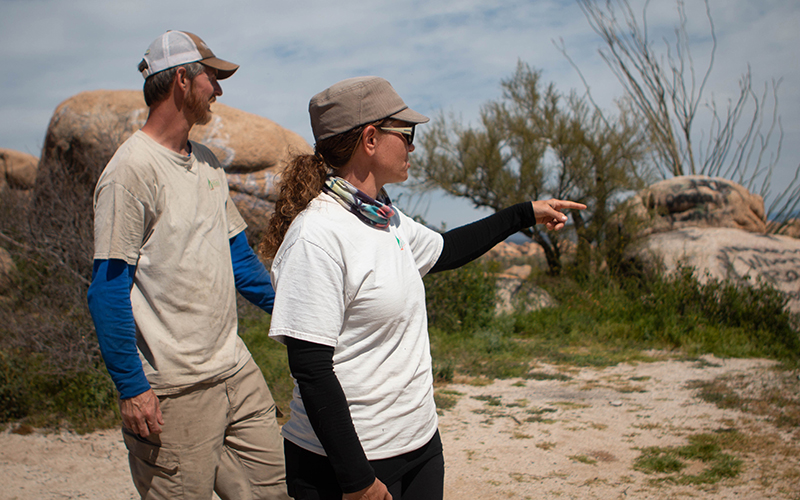FLORENCE – Nicole and Justin Corey were driving the Florence-Kelvin Highway last year when they saw boulders – clusters and stacks of them – splattered with paint; one was entirely coated with a spray-painted red heart and the outline of a face.
Florence residents remember when the rocks were free of defacement. For years before the Coreys intervened, those who stopped to gawk at the field of boulders saw “Ashley loves Matthew” and “So-and-so was here.”
It took the Coreys one year to obtain all the tools to embark on a two-week project to blast the paint off the rocks. They’re the founders of Natural Restorations, a nonprofit they started four years ago that removes trash and graffiti from outdoor recreation and wilderness areas.
In March, they spent two weeks with their dedicated restoration team, which is comprised of the Coreys and three contracted military veterans, cleaning up the much visited area. It all started when they spotted those boulders a year ago.
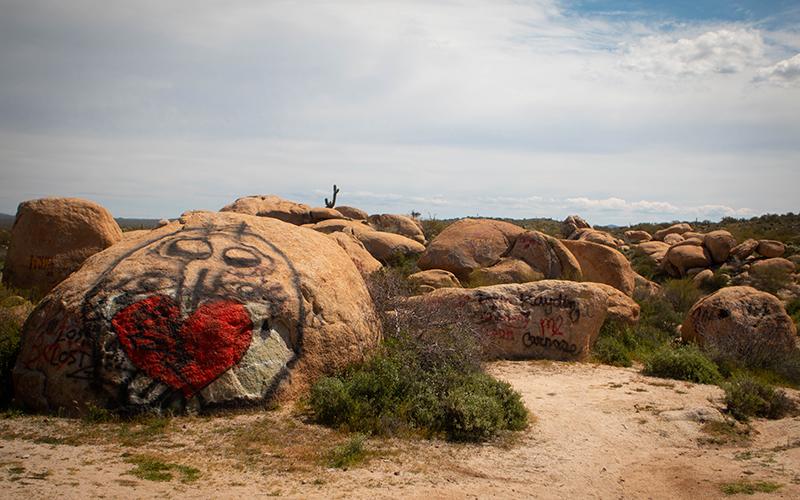
The graffiti Natural Restorations cleans is mostly names or short phrases without artistic merit. “I think it’s just kids being stupid,” executive director and co-founder Nicole Corey said. (Photo by Delia Johnson/Cronkite News)
“We feel that everyone should be able to come out into nature and enjoy this beautiful area with all the boulders without seeing profanity and people professing their love to their girlfriend or boyfriend on the rocks,” Nicole Corey said.
Graffiti is an ongoing problem on public and publicly accessible land in Arizona. It’s seen in such places as the Grand Canyon and Superstition Mountains, along with vandalism. In 2016, actress Vanessa Hudgens paid a $1,000 fine for carving a heart with her and her boyfriend’s names into a red rock in Sedona. In 2018, a family vandalized Labyrinth Canyon in the Glen Canyon Recreation Area, and the photos of their etched names on the rocks went viral, Arizona’s Family reported.
Virtually every rock in the cluster of boulders near Florence, which is southeast of Phoenix, had graffiti on it – names, symbols, social media handles, artwork or ridiculous gibberish. Nicole said their five-member team removed 20,242 square feet of graffiti.
The restoration project cost about $20,000, Nicole said, between purchasing all of the products, the graffiti-removing chemicals, a rental truck, a water trailer and hiring the veterans.
“When people just go buy an under-$5 can of spray paint, they’re doing thousands and thousands of dollars of damage,” Nicole said.
Healing through nature and hard work
The Coreys, who describe themselves as outdoor-oriented, grew up camping and spending time outdoors in Flagstaff, where Justin is from, and Montana, where Nicole grew up. Their passion is to “come out and restore these areas so that everybody can enjoy them,” Nicole said. That’s what’s behind Natural Restorations, but they also stumbled into a way to connect military veterans with nature through the work.
The realization came when Justin’s best friend from high school returned from serving several tours of duty in the Middle East. Nicole said her husband’s friend came back with a traumatic brain injury and PTSD, and he struggled to reintegrate into civilian life.
Justin took him camping to detox in nature, and at the end of their trip, they decided to pick up all the trash around their camp that had been left by others. He told Justin that was the first time he had stopped to relax – and had stopped thinking about how he could get back to the war.
“He was just focused on the task at hand, and when he was done, he felt like he had made a positive impact on the area,” Nicole said. “That was kind of the ‘ah-ha’ moment for my husband, where he was like, ‘We can do something for the environment, but we can also do something for the veterans returning to our country.”
Sean Brooks, 42, is one of the three veterans hired for the Florence project; the Marine is the newest member of the crew. Brooks, his wife and their 1-year-old son camped in their RV during the entire graffiti-cleaning effort, along with the rest of the crew, at their campsite about a half mile from the boulders.
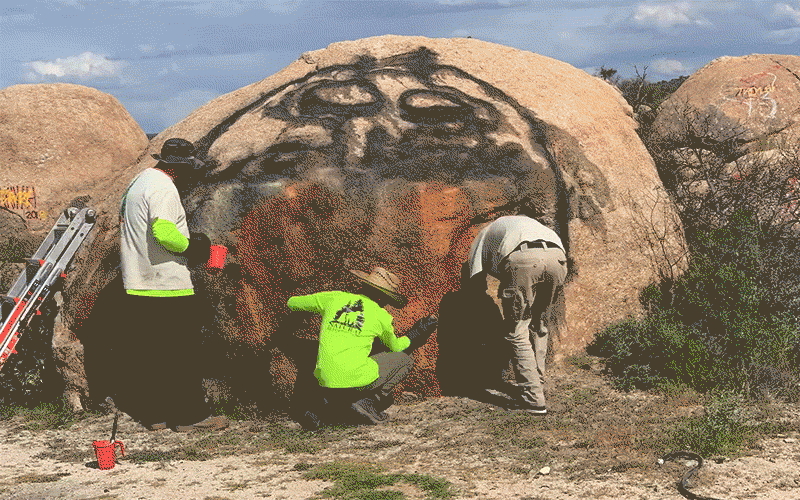
Natural Restorations spent two weeks with their dedicated restoration team cleaning up boulders.
(Clip courtesy of Natural Restorations/ GIF by Erica Figueroa)
The labor-intensive process involves painting a citrus terpene-based, biodegradable product on the graffiti, which agitates the paint, lifts it up and creates a soapy, slippery substance. The crew then sprays the boulders with a pressure washer to blast the gunk off.
Every little piece of graffiti is harmful to the environment, Brooks said. Pressure washing actually removes some of the rock, shrinking it a little bit more every time they complete the process. And some paint is easier to get out than others – the crew has to repeat the process multiple times if latex spray paint was used.
Brooks, who has been with the organization for a couple months now, has also worked on some of Natural Restorations’ trash removal projects, and said their five-person team will remove about 20,000 to 25,000 pounds of trash per week during such projects. The crew will fill 40-foot dumpsters, which are about the size of 40-foot shipping containers, full of trash on a weekly basis.
“The more pollution that we find, the more damage we find, the more you’re going to see parks close down to the public,” Brooks said. “And we don’t want that. So we like to keep them open and as clean as possible, for a long time.”
Brooks said the crew heard from residents that it’s mostly high school kids coming out and spray painting the boulders.
“We all probably did something of this nature back in high school. We were dumb and didn’t know any better,” Brooks said. “But it’s the planet that you’re inheriting. When it’s your time to be my age and be responsible and take care of your families, you’re going to have to deal with this. So, the more you take care of things now, the better it’s going to be for you when you’re adults.”
Nicole said by removing the graffiti, their hope is when new kids come into the area, they won’t see any spray painted rocks, and it won’t occur to them to deface the boulders.
“Trash attracts trash, graffiti attracts more graffiti,” Nicole said. “Somebody driving by, you can see this from the road. If they’re looking for trouble, they’re like, ‘Oh I can leave my mark and put my name on here because everybody else did, so it must be okay.'”
The crew works 40-hour weeks, Monday through Friday. Brooks said since he left the military, working with the organization is the first time he’s felt like he’s part of a family.
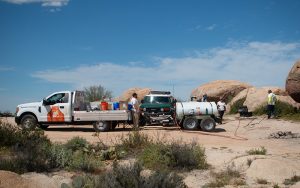
Three veterans work alongside Natural Restorations founders Justin and Nicole Corey to clean up graffiti on the Florence boulders. “Since I’ve been out of the military everything has been a job,” contract veteran Sean Brooks said. “This is the first time that I’ve actually felt, since the military, where I felt like I had a family.” (Photo by Delia Johnson/Cronkite News)
“You know, you get out of something like that (the military) where you have a brotherhood and a comradery and you get into the civilian side of things, and you just never feel like you really fit,” he said. “You can be really good at your job and enjoy the people you’re around, but you just don’t have that sense of belonging like you used to.”
Brooks said he’s found working outside, cleaning up graffiti and picking up trash alleviates a lot of inner stress that he didn’t even know he had.
“You can be yourself, and you know you can trust the people around you,” he said. “That’s huge when you have the background that we have.”
And working out in nature with Natural Restorations, making an impact on the environment was a slight awakening for Brooks.
“You have this fog in your brain, this kind of depression you don’t even realize is in you until it’s gone,” he said. “To come out to a job like this and to see that go away and your personalities bloom, you kind of get more of a sense of being.”
Since he started with the crew two months ago, he’s dropped 15 to 20 pounds.
A growing problem in Arizona
A grant through the Off-Highway Vehicle recreation fund, which is administered by Arizona State Parks and Trails, funded the boulder cleanup near Florence. Anyone who has an ATV, motorbike or anything similar has to register it, Nicole said, and that registration fee goes into a large fund to maintain the trails, build trails, restore trails and toward projects like this one.
Since the organization’s inception in 2015, the team has worked on 20 40-hour project weeks. The group goes all over the state but focuses on metro Phoenix.
Arizona’s outdoors have a growing problem with graffiti, said Dolores Garcia, public affairs specialist with the Bureau of Land Management’s Arizona State Office. The BLM has dealt with vandalism on several of its public sites – just about every place where there’s an open space and it goes regularly unmonitored, she said.
Proximity to urban areas tends to be a factor in where graffiti and vandalism is more apparent, but it doesn’t even matter how busy a site is, she added.
“Areas like the Grand Canyon see it on a regular basis,” Garcia said. “People carving into trees and tables, using markers to write on walls. It doesn’t matter if it’s out in the open and kind of rural or if it’s a high-use area, we see it pretty much on a lot of our sites – too many of our sites.”
The usual fine for graffiti on public lands is a $250 fine, plus costs to remove it, Mariela Castaneda, public affairs officer at the Bureau of Land Management’s Phoenix District, said in an email. However, every incident is different, so it’s seemingly impossible to give an estimate, she added.
“We are seeing it, and I don’t know that we’ve really been able to curb or find the educational route to curb the activities,” Garcia said.
Now that Natural Restorations has wrapped up work at the boulders, it’s setting up the next cleanup effort. The Coreys pitched their next venture to REI, and the proposed project would remove graffiti from Fish Creek Canyon in the Superstition Mountains; Broadway Cave in the Superstitions; Massacre Grounds Trail in the Superstitions; and Canyon Lake, a Salt River reservoir.
A generation losing its connection with the outdoors
Nicholas Bennett, an Air Force and Army veteran who has been with Natural Restorations for two years, said in general, the widespread issue with trash and graffiti stems from people losing touch with the outdoors.
“People spend more time involved with technology and their image on technology than they do with what’s around them,” Bennett said. “They’re not present. They’ve lost that connection with nature, and as a result, they lost the respect. So it’s not a big deal to take this boulder and to spray paint on it. Because they don’t have any sort of repercussions. The odds of them getting caught are next to zero, unless you spray paint your name on there.”
People who have spent a lot of time in nature don’t do things like that, he said.
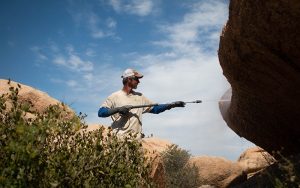
Justin Corey and the team work 8 hour days, five days a week to clean up the Florence boulders. The crew hopes the clean up effort will deter people from vandalizing the area in the future. (Photo by Delia Johnson/Cronkite News)
When Bennett first approached the Florence boulders, the sight disturbed him.
“It’s really sad what happens in a lot of these areas,” he said. “Whether it’s the graffiti or the trash, it’s really sad that it goes on to the scale that it does.”
Bennett said going through and cleaning up the area makes a significant impact on the “herd” mentality humans succumb to.
“Out here, if there was no graffiti on the rocks, that first time someone put a big piece of graffiti on some of the boulders, for example, it would mean a lot more than if they were already kind of covered up,” he said.
If a person sees heaps of trash on the ground, they don’t feel as bad leaving theirs on the ground as well; it’s almost like it’s camouflaged, he said. Once that first bottle cap or candy wrapper is on the ground, the problem only grows.
“What we do is very important because it preserves the only real asset that we have to give to our children as American citizens,” Bennett said. “This land is public to all American citizens. But if we destroy it, it’s not much of an asset to hand off, if we’re like, ‘Oh by the way, here’s this trash heap we’re going to give you – enjoy it!’ That’s not a very nice thing to do.”
Video by Jodi Guererro/Cronkite News
This story is part of Elemental: Covering Sustainability, a new multimedia collaboration between Cronkite News, Arizona PBS, KJZZ, KPCC, Rocky Mountain PBS and PBS SoCal.
AlertMe
